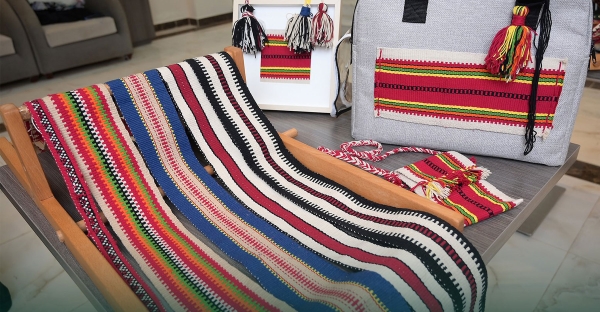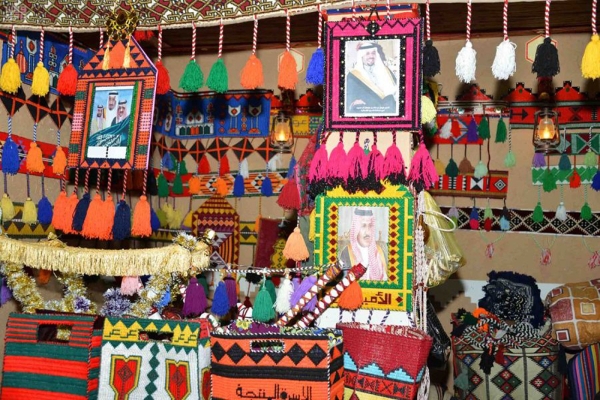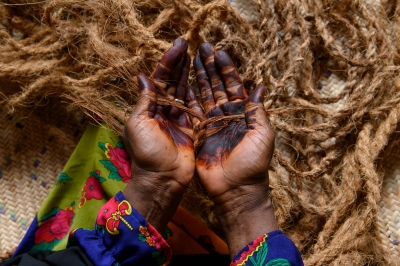


Handicrafts in the Northern Borders Province are the crafts, trades, and manual industries for which the Northern Borders Province is known in the Kingdom of Saudi Arabia. They emerged to meet the needs of the province's residents, in addition to the raw materials available in its natural environment. These crafts have been passed down through generations as part of the cultural heritage of the province's people.
Al-Sadu craft in the Northern Borders Province
One of the prominent handicrafts in the Northern Borders Province is Al-Sadu weaving, a folkloric heritage and a cultural and civilizational symbol of this province and other regions of Saudi Arabia, particularly those in the north. "Sadu weaving" was inscribed on the United Nations Educational, Scientific, and Cultural Organization (UNESCO) Representative List of Intangible Cultural Heritage in 2020.
Several products are made from Al-Sadu, including tents (Buyout Al-Sha'ar), which are among its largest items, in addition to Bishts, women’s clothing, accessories, rugs, carpets, covers, and embroidered cushions. The raw materials used in Al-Sadu weaving come from the natural desert environment, including sheep wool, goat hair, and camel wool. The craft involves several stages, starting with shearing, sorting, washing, and cleaning the wool using soap or ash to remove impurities. This is followed by drying, spinning, weaving, and dyeing with natural colors derived from plants, bark, and tree roots, such as saffron, henna, and others. The dominant colors in Al-Sadu weaving are black, white, red, and brown. The pieces are adorned with patterns, decorations, and artistic geometric designs that carry meanings linked to Bedouin life.
Several tools are used for weaving Al-Sadu threads in the Northern Borders Province, including the spindle, the loom, and wooden tools such as "Al-Minfash," a wooden beater lined with nails used to separate the wool after it has been collected, washed, and dried. The spinning process then begins, transforming the wool into twisted threads before continuing with the remaining stages of Al-Sadu weaving. Al-Sadu is traditionally associated with Bedouin women, who mastered this craft to build tents or Bayt Al-Sha’ar, create home furnishings, carpets, and cushions, and meet the family's needs for rugs, covers, and other essentials. Additionally, the province’s inhabitants decorated camel saddles, belts, and ornaments with Al-Sadu patterns.
Due to the significance of Al-Sadu craftsmanship in the Northern Borders Province, the "Layali Al-Sadu 2024" festival was held in the province. The event was organized by the Municipality of Northern Borders Province in collaboration with the Tarfeeh Association for Entertainment Services in Arar City. The festival aims to introduce elements of the province's folkloric and cultural heritage and connect the current generation with the craft of Al-Sadu weaving through live demonstrations and simplified training workshops.
Textile industries in Northern Borders Province
In addition to the craft of Al-Sadu, the Northern Borders Province is known for textile industries, fabric weaving, sewing, embroidery, wool spinning, and spindle making, meeting local needs for textiles and clothing. Women in the Northern Borders Province play a significant role in these crafts.
One of the prominent textile products in the province is Al-Farwah, which is in high demand during winter when temperatures approach zero degrees Celsius. The handwoven farwah in the Northern Borders Province is distinguished by its elegant design and luxurious texture. It resembles the Mishlah but is lined with soft, fringed wool on the inside. The Tafilah Farwah is the most expensive, made from the hides and wool of young sheep, giving it a lightweight and delicate texture, making it a preferred choice for the elderly. It is followed by the Talianiyah Farwah, crafted from thick sheep wool. The production of Al-Farwah goes through several stages, starting with shearing and cleaning the wool, followed by lining and sewing. The entire process takes between seven and ten days.
Handicrafts in the traditional market of Arar
The traditional market in Arar City contributes to preserving several handicrafts for which the Northern Borders Province is known, such as traditional clothing making, sewing, weaving, embroidery, and wool spinning, in addition to incense burner making, Al-Hassir (mat) weaving, and local clarified butter extraction.
The traditional market was established in 2016 and consists of forty-four shops. It is designed in a traditional style with heritage-inspired architecture and is considered one of the prominent heritage destinations in the Northern Borders Province. The market attracts local craftswomen, with dedicated shops provided to them free of charge, where they showcase their textiles and handmade products. It features a variety of cultural and heritage items, aromatic plants, handmade fabrics, Al-Sadu products, traditional clothing, and local foods such as clarified butter, dried yogurt, and butter. Additionally, the market includes the Khuzama Hall, which offers training programs for productive families to enhance their skills. These programs cover topics such as sales and purchasing culture, saving strategies, and e-marketing, along with self-development courses.
Related quizzes
Related articles

